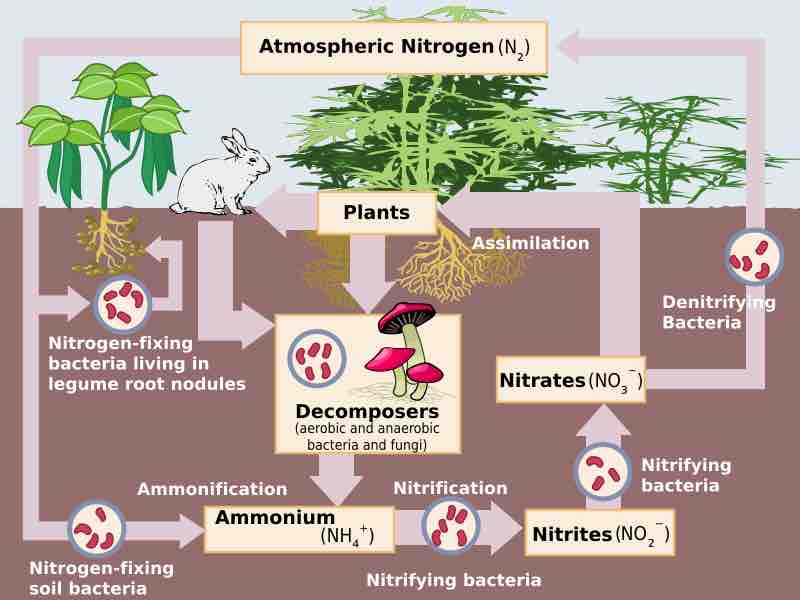Process of Nitrification
Nitrification is the process by which ammonia (NH3) or ammonium (NH4+) is converted to nitrate (NO3−). Nitrification is the net result of two distinct processes: oxidation of ammonium to nitrite (NO2−) by nitrosifying or ammonia-oxidizing bacteria and oxidation of nitrite (NO2−) to nitrate (NO3−) by the nitrite-oxidizing bacteria. Nitrification is an important step in the nitrogen cycle in soil. Nitrification is an aerobic process performed by small groups of autotrophic bacteria and archaea.
Chemistry of Nitrogen Compound Oxidation
Nitrification is a process of nitrogen compound oxidation (effectively, loss of electrons from the nitrogen atom to the oxygen atoms):
- 2 NH4+ + 3 O2 → 2 NO2- + 2 H2O + 4 H+ (Nitrosomonas)
- 2 NO2- + O2 → 2 NO3- (Nitrobacter, Nitrospina)
- NH3 + O2 → NO2− + 3H+ + 2e−
- NO2− + H2O → NO3− + 2H+ + 2e−
Both of these processes are extremely energetically poor, which leads to very slow growth rates for both types of organisms.
Ammonium Oxidation
The transformation of ammonia to nitrite is usually the rate limiting step of nitrification. Biochemically, ammonium oxidation occurs by the stepwise oxidation of ammonium to hydroxylamine (NH2OH) by the enzyme ammonium monooxygenase in the cytoplasm, followed by the oxidation of hydroxylamine to nitrite by the enzyme hydroxylamine oxidoreductase in the periplasm. Electron and proton cycling are very complex, but as a net result only one proton is translocated across the membrane per molecule of ammonium oxidized.
Nitrite Reduction
Nitrite reduction is much simpler, with nitrite being oxidized by the enzyme nitrite oxidoreductase coupled to proton translocation by a very short electron transport chain, again leading to very low growth rates for these organisms. Oxygen is required in ammonium and nitrite oxidation, meaning that both nitrosifying and nitrite-oxidizing bacteria are aerobes. As in sulfur and iron oxidation, NADH for carbon dioxide fixation using the Calvin cycle is generated by reverse electron flow, thereby placing a further metabolic burden on an already energy-poor process.

The nitrogen cycle
Schematic representation of the flow of nitrogen through the environment. The importance of bacteria in the cycle is immediately recognized as being a key element in the cycle, providing different forms of nitrogen compounds assimilable by higher organisms.
Human Applications of Nitrification
Nitrification is important in agricultural systems, where fertilizer is often applied as ammonia. Nitrification also plays an important role in the removal of nitrogen from municipal wastewater. The conventional removal is nitrification, followed by denitrification.